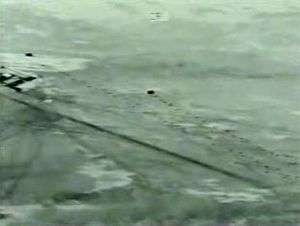Operation Rhino
Operation Rhino was a raid led by the United States Army's 75th Ranger Regiment (3rd Ranger Battalion), who were led by Colonel Joseph Votel,[1] and other SOCOM units on several Taliban targets in and around Kandahar, Afghanistan during the invasion of Afghanistan at the start of the War in Afghanistan (2001–present).[2]
| Operation Rhino | |||||||
|---|---|---|---|---|---|---|---|
| Part of the War in Afghanistan (2001–present) | |||||||
 Ranger parachute drop on objective "Rhino." | |||||||
| |||||||
| Belligerents | |||||||
|
|
| ||||||
| Commanders and leaders | |||||||
| Colonel Joseph Votel | |||||||
| Strength | |||||||
| 200 Army Rangers | Unknown | ||||||
| Casualties and losses | |||||||
| Few casualties, 2 killed in a helicopter crash while on standby for CSAR. | 30-100 killed | ||||||
Plan
The Ranger's objectives were to:
- Seize the landing strip (to become Camp Rhino)
- Destroy any Taliban forces
- Gather intelligence
- Assess the suitability of the landing strip for future operations
- Establish a forward aerial refuel/rearm point (FARP) for helicopters involved in the nearby operation at Objective Gecko
- Destroy major weapons and utilities
Operation
On the night of October 19, 2001, before the Rangers dropped, several targets on and around the objective were targeted by U.S. air power, first by bombs dropped from B-2 stealth bombers, then by fire from orbiting AC-130 aircraft. These air strikes resulted in a number of enemy KIAs and several enemy fleeing the area. Following the air strikes, the 4 MC-130 Combat Talon aircraft flew over the drop zone (DZ) at 800 feet. In zero illumination, the Rangers proceeded to exit the MC-130s.
A company-sized element of approximately 200 Rangers from 3rd Battalion, 75th Ranger Regiment, parachuted from four Lockheed MC-130 aircraft towards a desert landing strip named "Objective Rhino".[3] AC-130 gunships remained orbiting over the DZ in case the Rangers ran into trouble; the Rangers met almost no resistance (a solitary Taliban fighter attempted to engage the Rangers but was quickly shot and killed).[4]
Once on the ground, A Company, 3/75 Rangers, cleared several objectives, code-named TIN and IRON, without resistance. C Company moved out towards a walled compound, code-named objective COBALT. Psychological Operations (PSYOP) warfare specialists from the 9th PSYOP Battalion, broadcast messages on loud speakers in an attempt to coax any defenders to surrender but it was soon established that the compound was empty. With the landing strip secured, a MC-130 landed with medical personnel from the Joint Medical Augmentation Unit (JAMU) proceeded to evacuate and then treat 2 Rangers who had been injured during the jump.
U.S. Air Force Combat Controllers surveyed the landing strip, assessing it for possible future use (see: Camp Rhino). They also communicated with the AC-130s which were circling high overhead. When a small number of enemy troops and vehicles were spotted approaching the area, the AC-130s engaged and destroyed them. MH-60 and MH-47 helicopters, flown by the 160th Special Operations Aviation Regiment and taking part in the operation at Objective Gecko, soon arrived and were refueled and rearmed at the Forward Arming and Refueling Point (FARP) which had been established using MC-130 tankers. Once rearmed and refueled, the SOAR helicopters took off and left the area.
With all objectives completed, the Rangers and Combat Control Teams boarded the MC-130s which soon departed. PSYOP leaflets were left behind for any Taliban who might have ventured onto the scene over the coming days.
No casualties were suffered in the operation itself but 2 Rangers assigned to Combat Search and Rescue element supporting the mission were killed when their MH-60L helicopter crashed at Objective Honda in Pakistan - a temporary staging site used by a company of Rangers from 3/75. The helicopter crashed due to a brownout.[5]
Result
As a result of the raid, a base was set up over the airstrip and named Camp Rhino. It was then handed off to the 15th Marine Expeditionary Unit, who began leading forward operations throughout Kandahar along with the U.S. Army's 101st Airborne Division.
References
- LARRY KING LIVE Interviews With John Kerry, Randy "Duke" Cunningham, George Joulwan. CNN, December 14, 2001.
- "The United States Army in Afghanistan – Raid on Kandahar". Archived from the original on 16 February 2008.
- Gal Perl Finkel, Win the close fight, The Jerusalem Post, March 21, 2017.
- Neville, Leigh, Special Forces in the War on Terror (General Military), Osprey Publishing, 2015 ISBN 978-1472807908, p.34
- Neville, Leigh, Special Forces in the War on Terror (General Military), Osprey Publishing, 2015 ISBN 978-1472807908, p.36